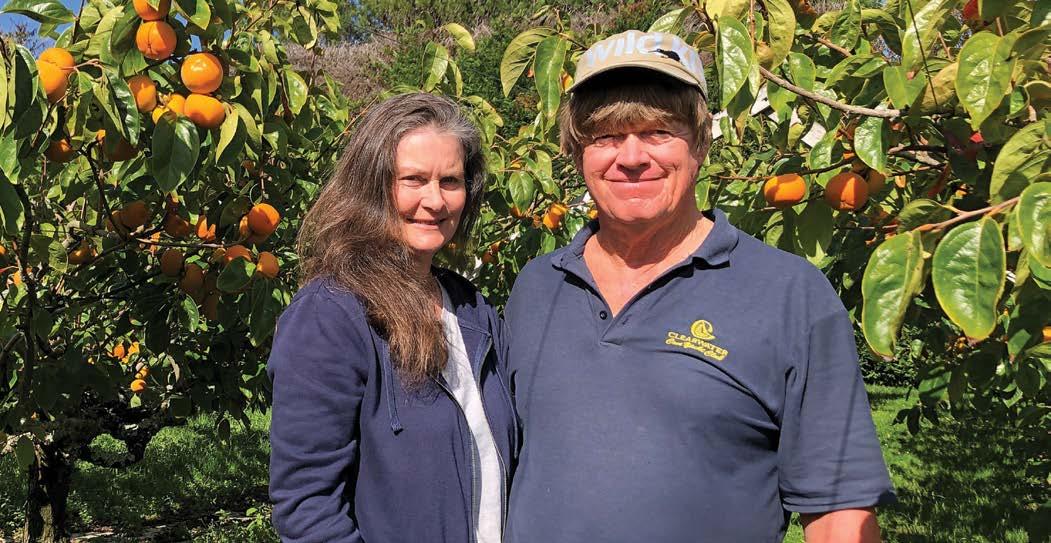
4 minute read
PERSIMMONS ON AUCKLAND’S DOORSTEP
Jeremy Noakes has been growing persimmons, mostly in the beautiful rural Matakana area, all his adult life.
By Delwyn Dickey
With a good harvest in full swing, Jeremy and wife Lynette Smith are pleased with their well-situated persimmon orchard, which along with Jeremy’s growing experience has seen them successfully navigate a challenging few years.
While busy Auckland city may seem a world away, it has influenced the area. Jeremy and Lynette are part of historic orcharding in the Matakana valleys and on the rich peat Omaha flatlands which began in the mid-1850s. Fruit was sent to the growing Auckland markets via sailing ships that plied the coast before roads were built.
Most of the valley orchards have given way to dairy farms and then divided into lifestyle blocks. Though the Omaha flats still produce mandarins, corn, blueberries and the like, many orchards have gone.
The Auckland market is still important for many remaining growers with around 30 percent of the 130 tonnes of high value fruit Jeremy and Lynette grow annually going there. But the bulk is now destined for markets in Thailand, Singapore, Viet Nam and Australia, with the remainder sold at their onsite stall.
Despite good returns, persimmon orchard numbers have dropped considerably over the past few decades.
Along with nashi pears, persimmons were seen as the next big ‘kiwifruit’ back in the 1980s and 1990s. This saw large numbers of persimmon orchards being planted up, including by ‘Queen Street farmers’, often in areas the couple believe were unsuitable.
Urban sprawl into horticultural areas around Auckland, and experienced growers retiring has also had an impact.
“There were well over 200 growers back in the 1990s. The number has settled on about 26 or so for about the last 10 or 12 years,” says Jeremy. Around 80 percent of these current export growers are in the Gisborne area, with two of these producing around half of all export fruit, he says.
A sub-tropical fruit, persimmons need a long warm growing season. Brittle branches make the trees vulnerable to wind damage with structural supports needed. Like most crops they don’t like wet feet so need free draining soil.
Their 3.3 canopy hectare Fuyu persimmon orchard sits on gently sloping north-facing land with Casuarina and Leyland Cypress shelter belts, and a mix of clay and volcanic soils. This has proven to be well suited to persimmon production over the 17 years they have owned it.
Jeremy’s experience has been needed for over the last five years especially. First came Covid-19 challenges and the worst drought the orchard had experienced in 2020.
This was followed in the 2022 to 2023 period by the wettest ever growing season. After a wet winter, spring and wet summer the couple had resolved themselves to a poor harvest and planned a boating trip in the Bay of Islands as compensation when the Auckland floods and then Cyclone Gabrielle came along.
And while they lost a shelter belt or two during the big wet, the persimmon trees remained healthy and producing well, as they had during the preceding drought.

Accommodation needs and a short five-week harvest period mean Recognised Seasonal Employer workers aren’t suitable for the orchard. This sees the three casual workers on site during the year joined by regular pickers – mostly hard-working seniors, some over 70.
Another hard-working senior is the grading/packing machine – an older apple grader refitted as an electronic grader for persimmons about 15 years ago. When T&G stopped processing persimmons in Pukekohe, Lynette and Jeremy bought all the machinery and brought it north –extending the shed.
Seven years ago Lynette pulled the plug on 15 years of commuting into the CBD to her job as a tax lawyer, taking over admin for the business including export compliance. She notes that the amount of paperwork involved for growers to stay compliant for domestic and especially export markets just keeps growing.
The property has been NZGAP certified for many years –that’s one audit, she says. Although most produce goes by sea freight in reefer containers, another audit is needed for their produce to be air freighted. Then a third audit kicks in for it to go to a specific export market, she says.
Lynette has concerns about some things agreed to for market access into the likes of the United States and China for example. These can see protocols too difficult for that access to be meaningful. It’s market access on paper but not in reality, she says.
Meanwhile, the city’s influence increases with heavy traffic now common as Auckland day-trippers visit the popular Matakana markets. Almost all persimmons at their orchard stall are now bought by these visitors pulling off the road and venturing up their drive.










